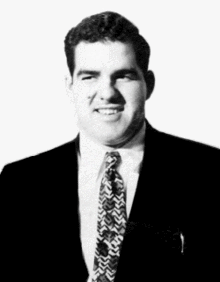Harry Daghlian
Harry Daghlian | |
|---|---|
 Daghlian c. 1944 | |
| Born | Haroutune Krikor Daghlian Jr. May 4, 1921 Waterbury, Connecticut, U.S. |
| Died | September 15, 1945 (aged 24) Los Alamos, New Mexico, U.S. |
| Cause of death | Acute radiation syndrome |
| Resting place | Cedar Grove Cemetery |
| Education | Massachusetts Institute of Technology Purdue University (BS) |
| Occupation | Physicist |

Haroutune Krikor Daghlian Jr. (May 4, 1921 – September 15, 1945) was an American
Daghlian was irradiated as a result of a criticality accident that occurred when he accidentally dropped a tungsten carbide brick onto a 6.2 kg bomb core made of plutonium–gallium alloy. This core, subsequently nicknamed the "demon core", was later involved in the death of another physicist, Louis Slotin.
Early life and education
Haroutune Krikor Daghlian Jr., of
Criticality accident and death
During an experiment on August 21, 1945, Daghlian was attempting to build a
Daghlian reacted immediately after dropping the brick and attempted to knock the brick off the assembly without success. He was forced to disassemble part of the tungsten-carbide pile in order to halt the reaction.[6]
Daghlian was estimated to have received a dose of 510
-
The two physicists Louis Slotin (with sunglasses) and Harry Daghlian Jr. (seated middle) during the Trinity Test preparation in July 1945. Both physicists died following supercriticality accidents.
-
The sphere of plutonium surrounded by neutron-reflecting tungsten carbide blocks in a re-enactment of Daghlian's 1945 experiment[4]
-
Harry K. Daghlian's blistered and burnt hand, photographed on August 30, 1945, after he received his fatal radiation dose. He died 16 days after this photo was taken.
Legacy
As a result of the incident, safety regulations for the project were scrutinized and revised. A special committee[specify] was established to review any similar experiments and recommend appropriate safety procedures. This change of procedures included needing a minimum of two people involved in such an experiment, using at least two instruments monitoring neutron intensities with audible alerts, and preparing a plan for operating methods and any contingencies that might occur during similar experiments.[8] Additionally, discussions and designs for remote-controlled test devices were initiated, eventually leading to the creation of the Godiva device.[citation needed]
These changes did not prevent another criticality accident from happening at Los Alamos the following year. Louis Slotin, a colleague of Daghlian's, was killed in 1946 while performing criticality tests on the same plutonium core.[4] After these two incidents it became known as the "demon core",[9] and all similar criticality experiments were halted until remote-controlled assembly devices were more fully developed and available.[8]
In 2000, the city of New London erected a memorial stone and flagpole in Calkins Park to honor Daghlian. His surname is misspelled "Daghiian" on the monument. The monument bears an inscription: "though not in uniform, he died in service to his country."[7]
References
- ^ a b Baumann, Paul (August 6, 1985). "NL man was 1st victim of atomic experiments". The Day. pp. 1, 4. Retrieved August 15, 2015.
- ^ "Harry Daghlian". Atomic Heritage Foundation. Archived from the original on August 30, 2015. Retrieved August 15, 2015.
- ^ "Harry Daghlian, Jr., wins Purdue honor". The Day. April 1, 1941. p. 3. Retrieved August 15, 2015.
- ^ a b c d McLaughlin, Thomas P.; Monahan, Shean P.; Pruvost, Norman L.; Frolov, Vladimir V.; Ryazanov, Boris G.; Sviridov, Victor I. (May 2000), A Review of Criticality Accidents (PDF), Los Alamos, New Mexico: Los Alamos National Laboratory, pp. 74–75, LA-13638, archived (PDF) from the original on September 27, 2007, retrieved April 21, 2010
- ^ ISBN 978-1-61234-890-2. Retrieved November 30, 2021.
- ^ ISBN 0-02-921620-6.
- ^ a b Slosberg, Steven (June 8, 2000). "A quiet victim of a horrific war he helped end". The Day. p. C1. Retrieved August 15, 2015.
- ^ OSTI 4343762. TID-5360. Retrieved August 8, 2015.
- ^ Wellerstein, Alex. "The Third Core's Revenge". Restricted data blog. Archived from the original on April 7, 2014. Retrieved April 4, 2014.[unreliable source?][self-published source]


![The sphere of plutonium surrounded by neutron-reflecting tungsten carbide blocks in a re-enactment of Daghlian's 1945 experiment[4]](http://upload.wikimedia.org/wikipedia/commons/thumb/1/13/Partially-reflected-plutonium-sphere.jpeg/200px-Partially-reflected-plutonium-sphere.jpeg)
